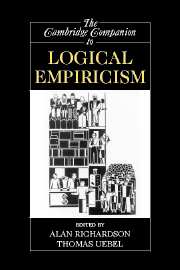Book contents
- Frontmatter
- Introduction
- Part I The Historical Context of Logical Empiricism
- Part II Logical Empiricism: Issues in General Philosophy of Science
- Part III Logical Empiricism and the Philosophy of the Special Sciences
- Part IV Logical Empiricism and its Critics
- 12 Wittgenstein, the Vienna Circle, and Physicalism: A Reassessment
- 13 Vienna, the City of Quine’s Dreams
- 14 “That Sort of Everyday Image of Logical Positivism”: Thomas Kuhn and the Decline of Logical Empiricist Philosophy of Science
- Bibliography
- Index
- Series List
12 - Wittgenstein, the Vienna Circle, and Physicalism: A Reassessment
from Part IV - Logical Empiricism and its Critics
Published online by Cambridge University Press: 28 January 2008
- Frontmatter
- Introduction
- Part I The Historical Context of Logical Empiricism
- Part II Logical Empiricism: Issues in General Philosophy of Science
- Part III Logical Empiricism and the Philosophy of the Special Sciences
- Part IV Logical Empiricism and its Critics
- 12 Wittgenstein, the Vienna Circle, and Physicalism: A Reassessment
- 13 Vienna, the City of Quine’s Dreams
- 14 “That Sort of Everyday Image of Logical Positivism”: Thomas Kuhn and the Decline of Logical Empiricist Philosophy of Science
- Bibliography
- Index
- Series List
Summary
INTRODUCTION: THE “STANDARD ACCOUNT” AND ITS LIMITATIONS
The precise nature of Wittgenstein's relationship to the Vienna Circle has been much debated, and there are deep disagreements about the strengths and weaknesses of the different positions attributed to the principal protagonists. However, there has been a widespread consensus about the overall character of the encounter: the early Wittgenstein was an important influence on the founders of logical empiricism, and the later Wittgenstein one of its leading opponents. In other words, the “standard account” of Wittgenstein's relations with the Vienna Circle is that the early Wittgenstein was a principal source and inspiration for the Circle's formulation of its positivistic and scientific philosophy, while the later Wittgenstein was deeply opposed to the logical empiricist project of articulating a “scientific conception of the world.”
However, this telegraphic summary of a complex and intricate relationship is at best only half-true and at worst deeply misleading. For it amounts to an oversimplified template that prevents our appreciating the fluidity and protean character of the philosophical dialogues that took place at the time, both between Wittgenstein and various members of the Vienna Circle, and among the logical empiricists over the value of Wittgenstein’s contribution. Furthermore, Wittgenstein’s own views changed rapidly and repeatedly during the 1920s and 1930s. Many of the participants in these discussions gave expression to a wide range of different views; taken out of context, their formulation of those views can easily strike a contemporary reader as clear anticipations of positions that are now standard items of philosophical terminology, such as physicalism, verificationism, or a use theory of meaning. Nevertheless, at the time those positions had not been articulated with anything like the degree of clarity that we now take for granted. In retrospectively identifying and attributing clear-cut positions, lines of influence, and axes of disagreement to Wittgenstein and his interlocutors in Cambridge and Vienna, it is very easy to read back our current understanding of familiar terminology and the associated distinctions into a time when those terms were used in a much more open-ended way.
- Type
- Chapter
- Information
- The Cambridge Companion to Logical Empiricism , pp. 305 - 331Publisher: Cambridge University PressPrint publication year: 2007
- 14
- Cited by

